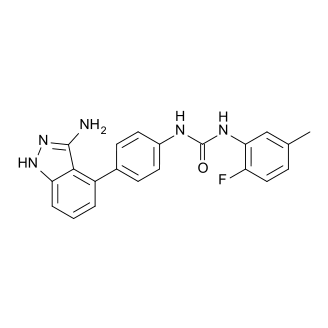Linifanib With Chemotherapy Improves PFS in NSCLC
Adding linifanib to a carboplatin/paclitaxel regimen improved progression-free survival over placebo in advanced non-squamous NSCLC patients.
Chemical structure of linifanib

The addition of linifanib to a carboplatin and paclitaxel regimen offered significantly improved progression-free survival (PFS) over placebo in a randomized phase II trial of patients with advanced non-squamous non–small-cell lung cancer (NSCLC).
Previous work has shown that adding inhibitors of VEGF to standard chemotherapy can improve survival outcomes in advanced NSCLC. Linifanib (Abbott Laboratories) is a tyrosine kinase inhibitor with activity against VEGF and PDGF receptors. “Single-agent activity of linifanib in phase I and II clinical studies in patients with advanced NSCLC encouraged further evaluation of linifanib as a component of therapy for these patients,” wrote study authors led by Suresh S. Ramalingam, MD, of Winship Cancer Institute of Emory University in Atlanta.
The new study randomized 138 patients with stage IIIB/IV non-squamous NSCLC to either carboplatin, paclitaxel, and placebo (47 patients), or those two agents along with linifanib 7.5 mg daily (44 patients) or 12.5 mg daily (47 patients). Results were published online ahead of print on January 5 in the Journal of Clinical Oncology.
The median PFS was 5.4 months in the placebo group, 8.3 months in the lower dose linifanib group, and 7.3 months in the higher dose group. These results yielded a hazard ratio for PFS of 0.509 for the low-dose linifanib vs placebo (P = .022), and 0.640 for higher-dose vs placebo (P = .118).
Overall survival (OS) was not significantly different between the groups, but there was a modest trend toward improvement with the study drug. The median OS was 11.3 months with placebo, 11.4 months in the 7.5 mg linifanib group (P = .779), and 13 months in the 12.5 mg linifanib patients (P = .650). The 12-month survival rates in the three groups were 45%, 44%, and 54%, respectively.
The objective response rate (ORR) was highest in the lower-dose linifanib group, at 43.2%; placebo and higher-dose patients had ORRs of 25.5% and 31.9%, respectively.
There was increased toxicity seen in both arms with the study drug, though overall rates of serious adverse events (AEs) were similar in the higher and lower dose groups. The most common AEs with linifanib were diarrhea, anemia, hypertension, dysphonia, and others. The only serious AE that occurred in linifanib patients more often than placebo patients was thrombocytopenia.
The authors noted that other attempts at VEGF inhibition as first-line therapy for NSCLC have not met with success. This study shows promise for linifanib, in particular with the use of a predictive biomarker, CYFRA 21-1, which in this study was associated with improved PFS with linifanib.
“Although additional studies of linifanib in NSCLC are not currently planned, further evaluation of linifanib in patients with the identified biomarker signature is warranted,” the authors concluded. “These findings are also of potential significance for other antiangiogenic agents presently under development for NSCLC.”
Newsletter
Stay up to date on recent advances in the multidisciplinary approach to cancer.